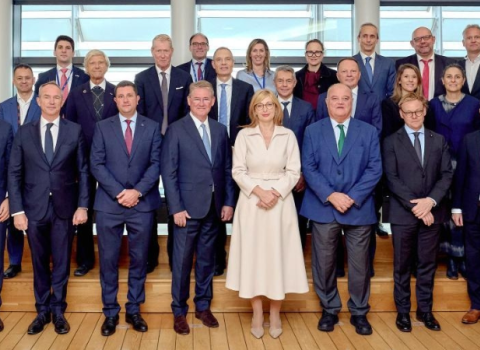They may only contain basic equipment, but fab labs can still make a difference to the early life of a start-up

From fab lab to offshore wind farm, BladeBUG in action. Photo: BladeBUG Limited
The “fab lab” was born at MIT in the early 2000s, with the idea that having access to basic computer-controlled fabrication devices, such as a digital printer, a laser cutter and a milling machine, would allow you to make (almost) anything. Wildly popular with MIT students, the concept quickly spread, with many cities adding a fab lab or “maker space” to their innovation ecosystems. The Fab Lab Network now claims more than 1,750 fab labs around the world, in more than 100 countries.
Many universities have also set up fab labs, primarily for students to work on their academic projects, but also with the idea of opening up to a wider community of innovators. And despite a lingering feeling that they are mainly for hobbyists, some serious start-up founders have made use of university fab labs.
Take Chris Cieslak, who had worked in the wind power industry for a decade designing turbine blades when he decided to start his own company. His idea was to make a robot that could help technicians inspect and repair these blades, a procedure usually carried out at great height and under challenging conditions.
A robot’s first steps
He joined an entrepreneurship scheme at Imperial College London, where he had studied composite materials engineering, and there got to know the university’s fab lab, the Advanced Hackspace. He then became one of its “hackers in residence”, a scheme that offers access to the fab lab’s resources in exchange for sharing expertise with students and helping keep the place in order.
“That enabled me to have a place to work and the facilities to make a prototype,” Cieslak recalls. He made use of 3D printers and laser cutters, along with electronics tools from soldering irons up. But the people he met were just as important. “I’m very much a mechanical engineer, but I was developing a robot that involved electronics, software and mechanical engineering, so it enabled me to meet people with other skills who could help me out.”
That open innovation ethos, where people share ideas and help with each others’ projects, was stimulating, but also a potential worry when it came to intellectual property. Luckily, Cieslak was able to secure a government grant under the Innovate UK scheme, part of which helped pay for a patent application. “Once that patent had been filed, it was easier to do more development of the robot and see it in the lab space.”
He also acknowledges that being able to say he was building his prototype in Imperial’s Hackspace was an asset in winning the grant. “That ticked a lot of boxes, and the grant enabled me to commit full time to BladeBUG.” The College also provided support on entrepreneurship issues through its Enterprise Lab.
After a year in the Hackspace, it was time for BladeBUG to go it alone. “I had been able to prove the concept enough to justify going out and forming a proper company, with its own premises and equipment,” Cieslak says. He left Imperial with another Innovate UK grant in his pocket, and Hackspace colleague Aksat Shah as chief technology officer.
Now with a staff of 10, BladeBUG is moving from pure R&D to commercial development. “We are running early adopter pilot programmes, and doing demos for potential customers. There is still work to do on the robot, but we need to do that with end-users.”
Fab labs for molecular biology
Patrick Torbey took advantage of GreenLab, a specialist fab lab at Sorbonne University set up to give students and others access to basic molecular biology equipment. He had completed a PhD in genome editing at the Ecole Normale Supérieure in Paris, and knew that he wanted to start a company. His idea was that the inherent ability of some plants to remove pollutants from the air could be harnessed to create natural indoor air purifiers.
“We wanted to carry out a very small, very simple proof of concept project, to show that it is possible to do something to the plant that increases its capacity to remove one particular pollutant from the air,” he recalls. “With that prototype, we could say to investors: this is what one person can do in a few months, let us have more resources and our own space to do something much better.”
At that time, in 2018, GreenLab’s resources were not particularly new or sophisticated. “It was very simple equipment, but it would still cost thousands of euros if you wanted to buy it yourself,” Torbey says. It included an autoclave to sterilise tools and other equipment, a small centrifuge, a warm water bath, fridges, a fume hood (very useful if you want to expose plants to air pollutants), and a basic PCR machine for working with DNA. “It was a bit limited, but enough to do some scrappy work,” he goes on. “I had a small grant, which I used to buy reagents and some specialist machines, but just having the space was very useful.”
Torbey could also count on the support of colleagues, for example borrowing space in a neighbouring lab’s growth chambers for his plants. But there was no formal support from the university, either for the science or the entrepreneurship. And that was just fine. “It was a very simple arrangement, where we just rented the space for a few months. I didn’t have the time to discuss collaborations or IP arrangements for something that was just an idea in my head.”
After three months, Torbey had his proof of concept. “We had a small plant that was able to remove one pollutant from the air significantly faster than a normal plant, and that’s what we were shooting for, with this prototype.” He and Neoplants co-founder Lionel Mora took this proof to potential investors, and they raised enough funding to establish a space and start hiring. Neoplants is now embedded in the Institute of Plants Sciences Paris-Saclay, where it also has some collaborative research projects. “We are 25 people, and we are scaling really fast.”
GreenLab filled an important gap for Neoplants, but such facilities are still few and far between. “The main bottleneck for synthetic biology start-ups right now is the availability of space to test your idea. If we have a lot more spaces like this, it would be much easier for start-ups to get through the proof-of-concept stage.”
Elsewhere in the Ecosystem...
- The European Innovation Council (EIC) has awarded Pathfinder grants totalling €145 million to 39 research projects hoping to bring early-stage technologies up to proof-of-concept level in five strategic areas: self-aware AI; tools to measure and stimulate activity in brain tissue; cell and gene therapy; hydrogen production; and engineered living materials. Most of the winners are universities and research organisations, but a few start-ups made the cut, such as Amsterdam-based Geneus Biotech, with its Furoid project; University of Twente cardiac biology spin-off River BioMedics; UCL immunotherapy spin-off Achilles Therapeutics; and Eden Tech in Paris, which had the nerve to submit a hydrogen project called MacGhyver.
- The EIC is looking for accelerators, incubators, and other organisations to join its partnership programme. “By providing services to EIC-funded innovators, you can boost your own visibility on a European level and gain access to the most promising projects, technologies, and companies on the EIC portfolio,” it says. The deadline for applications to be in the first cohort of 50 partners is 31 May.
The first edition of the European Startup Village Forum takes place on 12 April, showcasing results from an EU initiative set up to support innovative rural entrepreneurs and start-ups, particularly outside of farming, forestry and related sectors. Public and private organisations were invited last year to pledge support to the initiative, whether cash or in kind, with Huawei quick to put its money down. Research and innovation commissioner Mariya Gabriel will meet some of the early beneficiaries.





 A unique international forum for public research organisations and companies to connect their external engagement with strategic interests around their R&D system.
A unique international forum for public research organisations and companies to connect their external engagement with strategic interests around their R&D system.